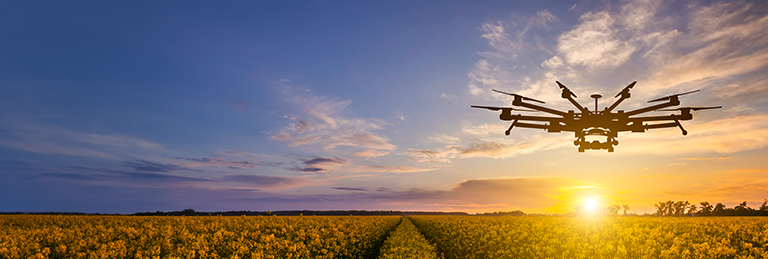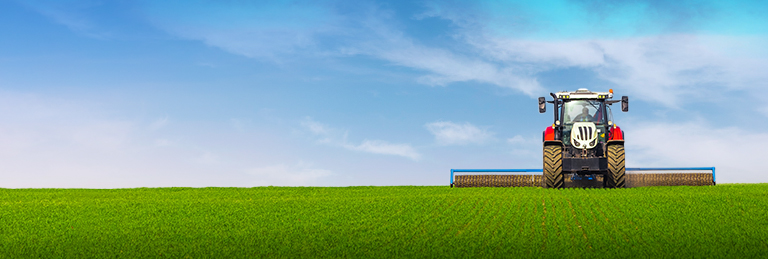It was JCB Chairman Anthony Bamford who struck on the idea of manufacturing an unconventional tractor while he was on holiday overseas in 1984. He saw an opportunity to develop a tractor that had high road speed and which would also be capable of field work, including heavy draft applications. His inspirational idea would become reality some years later when the world's first real tractor with full suspension was launched.
The Fastrac design has developed hugely from the first prototype built in 1987 in secret beneath the office block at JCB Transmissions in Wrexham, North Wales. The tractor brought together established technologies and components in a new way that not only provided exceptional ride comfort for an agricultural tractor thanks to the suspension incorporated in both axles but, as first tests were to prove, it also shattered the myth that suspension and ploughing is an impossible combination.
The design was developed and the prototypes entrusted to selected farmers for final feedback and refining before the result of the £12 million Project P120 was unveiled to the media and to the public at the Royal Smithfield Show in 1990 ahead of production start-up in spring the following year.
Agriculture Minister Baroness Trumpington cracked a bottle of champagne over the nose of the first Fastrac off the Cheadle assembly line as if launching a new ship, as factory staff and the men behind the inspired design – Sir Anthony (now Lord) Bamford; the late David Brown, Chief Engineer; Ray Clay, suspension engineer; and Mike Butler, JCB Landpower Managing Director.
Quite apart from being the first high-draft agricultural tractor with all round suspension and capable of top speeds up to 75kph (47mph), over the past 25 years the Fastrac has been the first to feature truck-standard disc brakes, multi-mode four-wheel steering, an anti-lock braking system (ABS) and self-levelling suspension. It was also the first – and remains the only – tractor to combine those features with an advanced, electronically-managed continuously variable transmission.
Paying tribute to the JCB engineers who brought the Fastrac concept to light, Lord Bamford said: “The Fastrac is a remarkable example of JCB's innovative engineering culture at its best. The concept of a tractor better equipped for road travel and transportation tasks but also very capable at undertaking demanding field work has proven its worth over the years, in terms of increased productivity and lower operating costs.
“At the same time, the Fastrac has advanced the principle of giving operators the best possible comfort and working environment so they can be as productive as possible while looking after their health and well-being. There are many cases of farmers with back troubles, often brought on by driving conventional tractors, who have been able to continue with field work thanks to the supreme ride and comfort of the Fastrac. That in itself is something worth celebrating.”
It was the field speed and comfort praised by early Fastrac users that influenced development of the Fastrac design to continually improve its field work capabilities while retaining its unmatched performance as a transport vehicle.
The Selectronic transmission with two-speed powershift was one of the first improvements to the Fastrac introduced two years after the 125 (120hp) and 145 Turbo (140hp) were launched in 1991. It doubled the number of working speeds available and brought a pre-select system for easy range and shuttle shifting.
And, of course, the new Fastrac acquired more power – a theme that would recur regularly in the ensuing years – with the addition of the 150hp Fastrac 155 in 1993 and the 170hp Fastrac 185.
In 1995, JCB pulled another surprise out of the bag with the Fastrac 1115 – a smaller, lighter, more nimble tractor with a top speed restricted to 50kph (31mph) so it could run on standard rather than high-speed rated tyres. It was joined later that year by a 135hp turbo-engined version. JCB engineers then applied their expertise devising multi-mode four-wheel steering systems for Loadall telescopic handlers by producing the Quadtronic system for the Fastrac 1115 and 1135.
This sophisticated set-up trimmed the tractors' turning circle by up to 25% and was so successful it remains a standard feature of today's Fastrac 4000 Series tractors. Operators can select two-wheel steer for the road, delay rear axle steering when turning out of tramlines and row crops or use True Tracking to keep the rear wheels faithfully following the fronts.
Circle steering gives the tightest turns and the tractors can even crab steer to counter slopes or spread their weight over four wheelings.
A more powerful, longer wheelbase model – the 148hp 2150 – joined the ‘small Fastrac' range when in 1998 the line-up was given a significant upgrade with new engines and the Autoshift 54x18 speed transmission. Introduced in the new two-model ‘large Fastrac' 3000 Series at the same time, this transmission's automatic three-speed powershift reduced the operator's workload and provided field and road modes for timely shifts under different circumstances.
The Smoothshift wet clutch transmission provided an operational and durability upgrade for all Fastrac tractors in 2000, and the following year, JCB's unique anti-lock braking system (ABS) brought new levels of safety and security. Although ABS was widely used on road vehicles, JCB engineers produced a system that not only coped with the heavy mass of a tractor wheel assembly on tarmac but also on slippery grass and loose-surface farm tracks.
JCB entered new tractor market sectors with the 250hp Fastrac 8250 in 2005 – the company's 60th anniversary year – and the 178hp to 270hp Fastrac 7000 Series in 2008. The former introduced CVT drive to the Fastrac range while the latter heralded JCB's own P-Tronic 24x9 speed semi-powershift transmission, which was installed to great effect in the Fastrac 3000 Xtra models from 2011.
A two-model 8000 Series and new levels of performance were established the same year with the introduction of the Fastrac 3210. This newcomer took the Fastrac range beyond 300hp for the first time and featured a new engine, electronic power modulating traction control and new control features for the V-Tronic stepless transmission.
Agritechnica 2013, meanwhile, signalled one of the most significant steps in the more recent Fastrac development story, when the current 4000 Series tractor was previewed.
With three power outputs from 175hp to 235hp, a CVT transmission, self-levelling suspension front and rear, multi-mode four-wheel steering, sophisticated hydraulics and a mid-mounted cab offering best-ever space and all-round visibility, the newcomer is the most advanced Fastrac ever.
JCB Chief Engineering and Innovation Officer Tim Burnhope said: “The Fastrac 4000 Series is such a complete tractor in all respects that it's attracting users who haven't operated a Fastrac before, as well as long-term enthusiasts. With a specification in terms of cab design, engine performance and transmission control and flexibility that's at least as good as other tractors of comparable power, plus the benefits of all-round suspension, steering and disc brakes, these first-time users recognise that they can now buy into the Fastrac's established advantages without compromise.”
As good as the standard Fastrac is, its potential for modification to suit specialist applications has also been recognised, with extended chassis Fastracs built for spraying and lime/fertiliser spreading, including six-wheel versions built as spreading vehicles in Australia.
Road/Rail conversions perform trackside vegetation work and other maintenance tasks and the Fastrac is seen at airports for clearing snow and ice from runways. But the most highly modified Fastrac is used by the US Army – it features a hydraulic loader and backhoe, is capable of travelling at speed in convoys and can be stowed in the load bay of a Hercules C-130 transport aircraft.
The Fastrac has also enjoyed moments of fame; it is the only tractor to have featured twice on the BBC Top Gear programme – at the original launch and when The Stig set a time of 2 minutes 57 seconds on the airfield test track.
And it's the only tractor to have launched a World record attempt. In 2006, a Fastrac 8250 capable of 105kph (65mph) got the high-geared JCB Dieselmax underway during the start-up procedure for its successful attempt on the diesel land speed record.
Today, the Fastrac in all its forms remains unique, providing a combination of design and technical features that promote high utilisation through its versatility, high productivity through its performance and with unmatched ride comfort in the field and on the road.
Fastrac History Timeline
1987 First High Mobility Vehicle (HMV) prototypes built to commence a testing, development and user evaluation programme for a tractor with higher speeds for more cost-efficient farm transport operations but also capable of routine field work from fertiliser spreading to ploughing.
1990 Pre-production JCB Fastrac shown to the media before being unveiled publicly at the Royal Smithfield Show in December.
1991 Production launched at new JCB Landpower facility in Cheadle and the Fastrac 100 Series is launched to the farming public at the Royal Show in July – two models of 120hp (125) and 140hp (145 Turbo) powered by 6-litre Perkins engine driving through an 18x6-speed transmission. Fastrac is the first purpose-built farm tractor with front and rear axle suspension for ride comfort and stability, and truck standard all-wheel disc brakes for high speed road travel at up to 65kph or 75kph (40mph or 47mph).
1992-1993 Fastrac launched into European markets and further afield in Israel and Australia.
1993 Fastrac 145 is replaced by two models, the 135 with 135hp and the 155 with 150hp (designated 130 and 150 in Germany) from Perkins 1000-series engines delivering increased torque through a new Selectronic 36x12 transmission with two-speed powershift, a steering column stalk twist grip for electro-pneumatic forward/reverse and range change pre-select actuated using the clutch pedal.
1994 Fastrac 185 launched at the Royal Show with 5.9-litre Cummins B-series engine developing 170hp (DIN) and uprated rear axle and Selectronic 36x12 speed transmission. All Fastracs get larger side windows, an air suspension seat option and rear hitch controlled diff lock. The Fastrac 155 is awarded a Silver Medal in the RASE Machinery Awards Scheme.
1995 Fastrac 1115 launched at the Royal Show – a smaller, lighter tractor weighing 5300kg with 115hp Perkins 1000-series engine, Selectronic 36x12 transmission and 50kph top speed. Joined by the 135hp 1135 later the same year. Fastrac 125 ceased production.
1995 JCB receives the 1994 Prince of Wales Award for Innovation for development of the Fastrac.
1996 Fastrac 1115 and 1135 tractors get optional Quadtronic four-wheel steering with selectable two-wheel, true tracking, proportional, delayed rear and crab steering modes giving added headland and farmyard manoeuvrability, tramline tracking and up to 25% tighter turning circle. It's the first such steering system on a tractor of this size and power.
1996 Fastrac 1125 with 125hp launched at the Royal Smithfield Show, powered by a higher torque Perkins 6-litre engine also featuring in the re-named 1115S, to create a three-model range. New twin ram hydrostatic steering and air-over-hydraulic brakes also introduced.
1996 JCB Fastrac design and development team awarded the RASE Agricultural Machinery & Mechanisation Award and the Design Council Award for Innovation.
1998 Fastrac 2000 Series replaces 1100 Series, comprising three uprated models with Perkins 1000-series engines of 115hp (2115), 125hp (2125) and 135hp (2135), plus the longer wheelbase 148hp 2150 two-wheel steer model. A new 50kph Autoshift 54x18 speed transmission has three-speed powershift and automatic shifting modes for different applications and the quieter cab is available with an optional multi-function performance monitor.
1998 Fastrac 3000 Series replaces 100 Series, comprising two models – the 3155 with 150hp from a new 6-litre Perkins 1000-series engine and the 3185 with a 170hp 5.9-litre Cummins B-series beneath a restyled hood. New 65kph Autoshift 54x18 speed transmission has three-speed powershift and automatic shifting modes for different applications. New triple-link front suspension (also on 2150) reduces turning circle by up to 2m. Optional multi-function performance monitor amongst cab interior revisions.
1998 JCB Fastrac earns a Silver Medal in the RASE Machinery Award Scheme.
1999 The 170hp Fastrac 3185 is the top competition prize won by Essex farm worker Neill Cowie, who set up as a contractor. Competition entry donations raised £33,723 towards JCB's £1m fund-raising initiative for the NSPCC.
1999 Sir Anthony Bamford receives the Sir Roland Burke Perpetual Challenge Machinery Trophy from the Royal Agricultural Society of England for the development of the Fastrac tractor.
2000 Hydraulic system improvements for all Fastrac tractors include larger capacity hydraulic pump options and single-handed quick release couplings.
2000 Royal Smithfield Show launch for Smoothshift transmission on all Fastrac models, with oil-immersed wet clutch for reduced service requirements and added durability, and stalk button engagement of pre-selected range and forward/reverse shifts.
2001 Fastrac 2000 and 3000 series tractors become the first to feature an anti-lock braking system (ABS), providing more secure braking in the field, on the road and on loose-surfaced farm tracks.
2002 Fastrac 3000 series uprated and identified by new rounded hood and roof panel styling. The 3190 has 170hp up to 15kph, 178hp thereafter and the 3220 has 185hp for field work, 200hp on the road. Both powered by a Cummins QSB5.9 engine with 24-valve cylinder head and electronic fuel pump management for more efficient fuel use, improved power delivery and up to 12% more torque. Increased 3pt lift capacity front and rear, and a new right-hand console with short-throw gear lever and electric spool valves with ‘Plus' specification.
2003 Fastrac 2140 with 142hp 5.9-litre Cummins engine and two- or four-wheel steering becomes the sole 2000 Series model, while the 3170 with 155hp replaces the 3155 with styling and specification similar to the 3190 and 3220.
2005 JCB claims a new spraying output record for a Fastrac 2140 with a 28m/2000-litre demount sprayer that maintained an average speed of 37kph to cover 104 hectares in an hour.
2005 Fastrac 8000 Series introduced in JCB's 60th anniversary year as a tractor aimed primarily at heavy ploughing, cultivating and sowing applications. Powered by 8.3-litre Cummins QSC with 250hp driving through a 65kph (40mph) V-Tronic CVT transmission with in-house software providing seamless or stepped speed changes selected through a new touch screen terminal.
2006 Fastrac 3000 Series introduces 6.7-litre Cummins QSB6.7 engine to the range, with electronic common rail fuel injection and power outputs of 198hp (3200) and 230hp (3230) – modest increases but with more torque at lower engine speeds.
2006 Specialised backhoe version of the Fastrac – the High Mobility Engineer Excavator – developed for the US Army capable of being driven, rather than transported, in a high-speed convoy. Capable of being carried in a Hercules C-130 transport aircraft, the HMEE has a 3m wheelbase a loader lifting more than 2 tonnes to and an excavator digging down to almost 4m.
2006 Fastrac 8250 capable of 105kph (65mph) gets JCB's high-geared Dieselmax World speed record car rolling during the start-up procedure.
2007 Fastrac 8250 awarded Gold Medal by the Royal Agricultural Society of England as part of its Machinery Awards Scheme. The Stig gets to grips with a Fastrac 8250, setting a 2m 57s time on the BBC Top Gear test track.
2008 Fastrac 2155 and 2170 introduced to replace the 2140 with 165hp and 178hp from a Cummins QSB6.7 engine driving through the Smoothshift 54x18 transmission providing a 10kph increase in top speed to 60kph. ‘Plus' specification option adds electronic spool valves
2008 Fastrac 7000 Series launched as an upper mid-range field and transport tractor with 70kph top speed, comprising three models with max power outputs of 178hp, 195hp and 230hp joined the following year by the 270hp 7270. All introduced self-levelling hydro-pneumatic suspension for the front axle as well as at the rear, the new P-Tronic 24x9 speed semi-powershift transmission, a larger new cab design and a monocoque chassis.
2011 Fastrac 3000 Xtra introduced at Agritechnica with the P-Tronic 24x9 semi-powershift transmission, Xtra-Drive brake pedal stop-start and new 7.4-litre AGCO Power (Sisu) engine with SCR emissions control and unique driver-selectable boost power for transport operations – 147hp and 172hp for the 3200 Xtra, 172hp and 201hp for the 3230 Xtra.
2011 Two new Fastrac 8000 Series tractors launched at Agritechnica following a preview at the Cereals Event featuring 8.4-litre AGCO Power (Sisu) engine with SCR emissions control, greater fuel economy and 279hp for the 8280 and 306hp for the 8310. Activ Traction grip control, new V-Tronic CVT transmission features and GPS-ready electronics infrastructure also introduced.
2013 Fastrac 4000 Series – three models with 175hp (4160), 208hp (4190) and 235hp (4220) – previewed at Agritechnica, set to replace the 2000 Series with a more powerful and advanced design featuring a 60kph stepless CVT transmission, self-levelling suspension at the front and rear, with the Advanced double-acting option providing greater stability and quicker switch-over of deck-mounted sprayers and other equipment, the new Command Plus cab and fresh styling
2014 Fastrac 3000 Xtra upgraded with Stage IV / Tier 4 Final emissions, fuel-saving low idle speed and P-Tronic transmission control refinements – all distinguishable by yellow painted wheel rims.
2015 Full-scale commercial production of Fastrac 4000 Series gets underway, the tractors rapidly attracting long-standing and first-time Fastrac owners alike for a wide range of farming applications.








